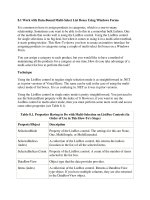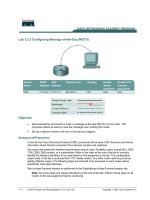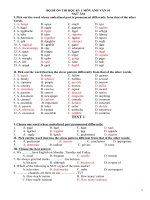Lab MPLS with Traffic Engineering
Bạn đang xem bản rút gọn của tài liệu. Xem và tải ngay bản đầy đủ của tài liệu tại đây (663.7 KB, 35 trang )
Lab
MPLS with Traffic Engineering
Last Update 2011.06.01
1.0.0
Copyright 2011 Kenneth M. Chipps Ph.D.
www.chipps.com
1
Source
• This lab was developed by ibarrere
• That is the only name listed on the site
• It is found in a blog post from May 2009 on
the web
site at
– />
• This looks like a very useful site
Copyright 2011 Kenneth M. Chipps Ph.D. www.chipps.com
2
MPLS in a Lab Environment
• As it is difficult to create a real MPLS
network in a lab environment and since
simulation programs do not offer a MPLS
cloud as they do for Frame Relay, this lab
will use an emulation program
• In this case GNS3 running Dynagen which
is controlling the Dynamips emulator
• How to use GNS3 is covered in detail in
another presentation on this web site
Copyright 2011 Kenneth M. Chipps Ph.D. www.chipps.com
3
Lab Network
• Here is the lab network as setup in GNS3
• To create the topology either
– Download and open this file in GNS3
• MPLS With Traffic Engineering Lab.net
– or
– Lay the routers out as the diagram that
follows shows
Copyright 2011 Kenneth M. Chipps Ph.D. www.chipps.com
4
Lab Network
• When the routers are placed be sure the
labels match as well
• Next the modules to be added to the
routers, which are all 7200 models
• Then the connections between the routers
are made
• To simplify the setup the modules are all
the same even though some of them are
not actually needed in all the routers
Copyright 2011 Kenneth M. Chipps Ph.D. www.chipps.com
5
Lab Network
Copyright 2011 Kenneth M. Chipps Ph.D. www.chipps.com
6
Modules Required
Copyright 2011 Kenneth M. Chipps Ph.D. www.chipps.com
7
Modules Required
• The modules are
– Slot 0
• C7200-IO-FE
– Slot 1
• PA-GE
– Slot 2
• PA-2FE-TX
– Slot 3
• PA-GE
Copyright 2011 Kenneth M. Chipps Ph.D. www.chipps.com
8
Connections
Copyright 2011 Kenneth M. Chipps Ph.D. www.chipps.com
9
Connections
Copyright 2011 Kenneth M. Chipps Ph.D. www.chipps.com
10
Lab Network
• The routers are all running this IOS
– c7200-advipservicesk9-mz.150-1.M5.bin
Copyright 2011 Kenneth M. Chipps Ph.D. www.chipps.com
11
Configuration
• As the configurations are lengthy for this
many routers they are provided as
separate links to copy and paste txt files
listed just below this lab’s link
• Download each one of these, then copy
and paste the contents to each router
based on the name of the file and the
corresponding router
Copyright 2011 Kenneth M. Chipps Ph.D. www.chipps.com
12
Verify Connectivity
• Let’s see if it worked
• Enter
– show mpls traffic-eng tunnels
• This shows
Copyright 2011 Kenneth M. Chipps Ph.D. www.chipps.com
13
Verify Connectivity
Copyright 2011 Kenneth M. Chipps Ph.D. www.chipps.com
14
Verify Connectivity
• Ping all of the interfaces
• For example from R4 to R5
– ping 10.10.1.2
• These should all work
Copyright 2011 Kenneth M. Chipps Ph.D. www.chipps.com
15
Verify Connectivity
• Examine the routing table
• Here from R0
Copyright 2011 Kenneth M. Chipps Ph.D. www.chipps.com
16
Verify Connectivity
Copyright 2011 Kenneth M. Chipps Ph.D. www.chipps.com
17
RSVP Capture File
•
•
•
•
•
Let’s open the same capture file
We will see how RSVP did its work for us
Go to frame 24
Expand all of the RSVP level
Here the two ends are talking to each
other in a path message over tunnel 2
• As we can see there is a lot to say
Copyright 2011 Kenneth M. Chipps Ph.D. www.chipps.com
18
RSVP Capture File
Copyright 2011 Kenneth M. Chipps Ph.D. www.chipps.com
19
RSVP Capture File
Copyright 2011 Kenneth M. Chipps Ph.D. www.chipps.com
20
RSVP Capture File
Copyright 2011 Kenneth M. Chipps Ph.D. www.chipps.com
21
RSVP Capture File
Copyright 2011 Kenneth M. Chipps Ph.D. www.chipps.com
22
RSVP Capture File
Copyright 2011 Kenneth M. Chipps Ph.D. www.chipps.com
23
What Do The Commands Do
• Let’s look at some of the commands used
to see what they do
– ip cef
• To turn on CEF – Cisco Express Forwarding
• This is required by Cisco routers doing tag
switching of which label switching is a form
• As Cisco says
– CEF switching is a proprietary form of scalable switching
intended to tackle the problems associated with demand
caching
Copyright 2011 Kenneth M. Chipps Ph.D. www.chipps.com
24
What Do The Commands Do
– With CEF switching, the information which is
conventionally stored in a route cache is split up over
several data structures
– The CEF code is able to maintain these data structures
in the Gigabit Route Processor
– The data structures that provide optimized lookup for
efficient packet forwarding include
• It is on by default in some devices
– mpls traffic-eng tunnels
• Enables traffic engineering on the router
Copyright 2011 Kenneth M. Chipps Ph.D. www.chipps.com
25









